Address any questions or comments regarding this newsletter to the individual authors listed after each article or to its editors, Nathan Johanning, 618-939-3434, njohann@illinois.edu or Bronwyn Aly 618-695-6060, baly@illinois.edu. The Illinois Fruit and Vegetable News is available on the web at: http://ipm.illinois.edu/ifvn/. To receive or be removed from email notification of new postings of this newsletter, contact Nathan Johanning or Bronwyn Aly at the phone numbers or email addresses above.
In This Issue:
Upcoming Programs (listings for beginning and established growers)
News & Announcements (Plant Clinic Still Open for Business, Great Lakes Vegetable Producers Network Roundtable Discussions, COVID-19 Resources from Illinois Specialty Growers Association, COVID-19 Resources from University of Illinois Extension, USDA Supports Specialty Crops Producers with Direct Payments for Losses Due to COVID-19)
Regional Reports (east central Illinois, west central Illinois (Quincy), St. Louis metro east, southwestern Illinois (Waterloo), southern Illinois (Murphysboro), Dixon Springs)
Fruit & Vegetable Production & Pest Management (Cleaning, Sanitization, and Disinfection on the Produce Farm: What’s the Difference and Why Does It Matter?, Modified Growing Degree Days for Insect Development (Base 50⁰ F, January 1 – May 19), Specialty Crops Soil Health Podcast – No-till Pumpkins, Overview of Tomato Pith Necrosis)
Upcoming Programs
See the University of Illinois Extension Local Food Systems and Small Farms Team’s website at:
http://web.extension.illinois.edu/smallfarm/ and the calendar of events at http://web.extension.illinois.edu/units/calendar.cfm?UnitID=629.
- Great Lakes Vegetable Producers Network – Roundtable Discussions. Every Wednesday 12:30 ET/11:30 CT from the first week of May through the first week of September. Great Lakes Vegetable Producer’s Network, a live weekly roundtable discussion during the growing-season for commercial vegetable producers in the Great Lakes and Midwest region. Join us! We broadcast live via Zoom at every Wednesday. Check out the website for the next upcoming topics. Next Wednesday, May 27 will be on pumpkins! If you have a pressing vegetable production issue that you would like discussed, simply email it, along with your phone number, to greatlakesvegwg@gmail.com.
- *CANCELED* Summer Horticulture Field Day. Thursday, June 11, 2020. Edwards Apple Orchard West 8218 Cemetery Rd, Winnebago, IL 61088. Given the current situation with COVID-19, we have made the decision to cancel Summer Hort Day. While it is a difficult decision to make, as an organization we feel it is our duty to keep our members safe. Coordinators for Summer Hort Day are working on ways to provide information typically delivered during this event through digital content channels. Be on the lookout for a physical mailer and email with a link and more information to members, much like we do to invite people to the typical Hort Day Event.
- Pumpkin Field Day. Thursday September 3, 2020 10:00 a.m. SIU Belleville Research Center, 2036 Charles Ln. Belleville, IL 62221. Variety and Pest Management trials and much more! Save the Date! More information to come. Contact Nathan Johanning at njohann@illinois.edu or 618-939-3434.
News & Announcements
Plant Clinic Still Open for Business
At this point in the season, crops are in the ground across the state and in varying stages of development. We wanted to make sure that growers were aware that the University of Illinois Plant Clinic was still open and ready to help identify pests and diseases. The press release below outlines the steps needed to mail samples into the clinic in order for them to meet COVID-19 state guidelines. I urge growers to remember this valuable resource when confronted with disease and pest problems. Correct identification saves time and money!
For those who may need to contact the Plant Clinic without internet capabilities, please see below:
Diane Plewa
Plant Diagnostic Outreach Specialist
Department of Crop Sciences
S-424 Turner Hall MC-046
1102 S Goodwin Ave
Urbana, Illinois 61801
Clinic Phone: 217-333-0519
Office Phone: 217-333-2478 to S-420
April 03, 2020
URBANA, Ill. - The University of Illinois Plant Clinic remains open to identify plant pests and diseases. New guidelines are in place to comply with all university of state guidelines related to COVID-19.
To send samples through the mail, use USPS and email the tracking number to the clinic. Since UPS or FedEx are no longer delivering to campus, if you must use their services, email the tracking number to the clinic, says Diane Plewa, plant clinic director. Staff will pick it up at the mailing location.
A drop off box is located at the south doors of Turner Hall on the U of I campus in Urbana for local residents. A submission form is available at the box and required for all samples.
All samples must include a submission form. For plant and insect samples, use the diagnostic sample form. For soil samples, use the nematology form, and for herbicide resistance and Palmer amaranth identification, use the molecular services form, Plewa says.
One may call the clinic at 217-333-0519 and leave a message for a follow-up call. Email correspondence is preferred.
"The clinic is making every attempt to process samples in a timely manner," Plewa says. "With the fluid situation, Illinois SCN type and HG type assays are on hold. Samples can still be submitted and will be stored until they can be processed."
Bronwyn Aly (618-382-2662; baly@illinois.edu)
Great Lakes Vegetable Producers Network Roundtable Discussions

University of Illinois Extension is participating in the Great Lakes Vegetable Producer’s Network, a live weekly roundtable discussion during the growing-season for commercial vegetable producers in the Great Lakes and Midwest region. Join us! We broadcast live via Zoom at 12:30 ET/11:30 CT every Wednesday from the first week of May to the first week of September. Check out the website for the next upcoming topics. Next Wednesday, May 27 will be on pumpkins!
If you have a pressing vegetable production issue that you would like discussed, simply email it, along with your phone number, to greatlakesvegwg@gmail.com.
Nathan Johanning (618-939-3434; njohann@illinois.edu)
COVID-19 Resources from Illinois Specialty Growers Association
The Illinois Specialty Growers Association website has an up to date tab with a wide range of COVID-19 resources available for specialty crop producers, including stimulus updates, guidelines for U-pick and direct sales, health and safety on the farm, etc. This site also has a link to the Illinois Farmers Market Association site. Information can be found at https://www.specialtygrowers.org/covid19
COVID-19 Resources from University of Illinois Extension
The University of Illinois Extension is continuing to update resources related to COVID-19. Information is divided into four main areas: families, businesses, food producers, and community leaders. While most of the information relative to specialty crops producers will be found under food producers, you may also find helpful information under the other three categories as well. This information can be found at https://extension.illinois.edu/global/resources-responding-covid-19
USDA Supports Specialty Crops Producers with Direct Payments for Losses Due to COVID-19
WASHINGTON, May 19, 2020 – As part of the Coronavirus Farm Assistance Program, the U.S. Department of Agriculture (USDA) today announced that it will provide up to $2.1 billion in direct payments to specialty crops producers. The payments will be based on losses where prices and market supply chains have been impacted and will help producers facing additional adjustment and marketing costs resulting from lost demand and short-term oversupply for the 2020 marketing year as a result of COVID-19.
- Producers that fall into one of the following categories may be eligible to receive a direct payment:
- Sales with a price loss of 5% or more between January 15 and April 15, 2020. Almonds, artichokes, beans, broccoli, cabbage, carrots, cauliflower, sweet corn, cucumbers, eggplant, lemons, iceberg and Romaine lettuce, dry onions, peaches, pears, pecans, bell and other types of peppers, rhubarb, spinach, squash, strawberries and tomatoes are eligible.
- Shipments that left the farm by April 15 and spoiled due to no market or for which no payment was received. All specialty crops are eligible.
- Shipments that have not left farm or mature crops that remained unharvested by April 15. All specialty crops are eligible.
Beginning on May 26, 2020, producers of all eligible commodities may apply for assistance through their local USDA Farm Service Agency Service Center. Specialty crops producers are encouraged to complete the application forms ahead of the application date. Producers can locate their service center and find application forms and additional information at farmers.gov/cfap.
The payments are one of several measures USDA is taking to support America’s specialty crops industry which has been greatly impacted by the COVID-19 national emergency. In addition to the direct payments, USDA has implemented the Farmers to Families Food Box Program, in which the USDA Agricultural Marketing Service is partnering with national, regional and local suppliers to purchase fresh produce, dairy and meat products and have suppliers package these products into family-sized boxes, then transport them to food banks, community and faith-based organizations, and other non-profits serving Americans in need. More information about the food box program is available at www.usda.gov/farmers-to-families .
USDA will also make an additional $873.3 million in Section 32 purchases of specialty crops products for distribution to food banks. The use of these additional Section 32 funds will be determined by industry requests, USDA agricultural market analysis and food bank needs. The latest purchase solicitations are available at www.ams.usda.gov/selling-food-to-usda-terms/solicitations.
Regional Reports
From east central Illinois (Champaign)… In the month of May we have gotten around three inches of rain, 2.5 of that in just the last couple of days. With the dry soils in the early part of the month and some early warm weather a lot of crops were put in the ground. Then we got a below freezing night. Luckily, in the Champaign area, we only had about 2 hours at or below freezing in the early morning hours and then the temperature rose quickly once the sun broke the horizon. Most producers have reported little to no damage. A few people lost some tomatoes that went out way too early and I had one report of some lost bunching greens. The strawberry blooms showed no sign of damage indicating the ground stayed relatively warm even in our few cold hours. The peach and apple blossoms had some visible damage but not many losses. Because of the recent cool weather many of the greens and lettuces have stalled.
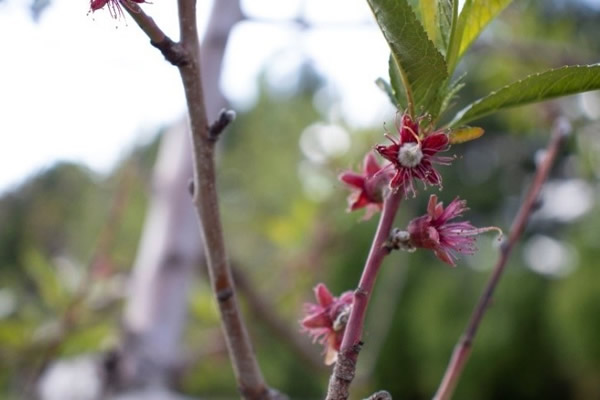
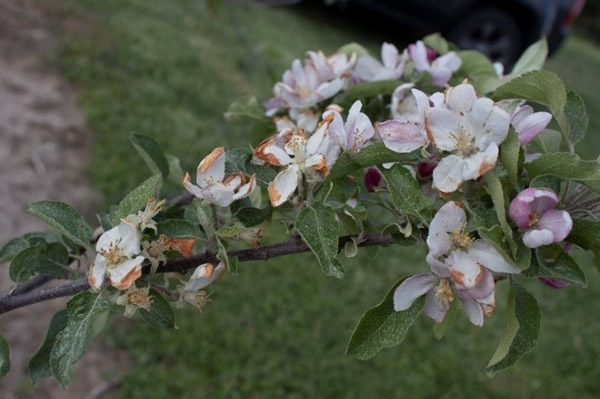
Peach (left) and apple (right) blossoms on Tuesday, May 12, 2020, after the freeze. Photos by Erin Harper.
Last week was a mad dash for everyone to get the crops in between the freeze and the forecasted 4 days of rain. Thankfully the rain held off for the most part until the weekend and people were able to get a lot planted. The fields, for now, remain saturated and planting has halted.
Only one of the local farmer’s markets is currently open but it has been going really well. The vegetable producers don’t have much in way of produce yet but they have been selling out or coming close each week. The cut flowers are also selling out and the vegetable transplants have increased in sales tremendously compared to previous years. Another market is opening for its first day as I write this and more will open on June 6th. Most of the regular markets in the area are continuing on with produce sales, including cottage foods, and social distancing guidelines; very few markets have cancelled for the season.
Erin Harper (217-300-2876; harper7@illinois.edu)
From west central Illinois (Quincy)… Like everywhere else in Illinois, we’ve been cold the past few weeks and really wet since the 15th, in which we got at least one “terrace topping” rain. We did manage to get in our second planting of sweet corn on May 10th, in good soil conditions. The first planting was emerged when we received two frosts (May 9 and 11) and is now recovered its coloration. The stand is not great though (it was just too wet after planting) but it will have to do.
We pulled the row covers out of our basement and placed on the strawberries to avoid frost injury. It was a good thing as the 2 feet we didn’t get covered on one end had about half of the blooms killed. The strawberries just aren’t maturing due to the cold and cloudy conditions. The only good thing is we haven’t irrigated much, just to supply the fertilizer for the crop. We have about a 2/3’s crop, based upon bloom count. It must have been the cold and cloudy fall last year that limited the number of productive crowns. We do have 4-5 crowns per plant, but several of them are not fruiting crowns, so they must have formed too late.
Asparagus has been hit and miss with the weather. We’ve had excellent growth at times and then just about nothing. The frosts that we received didn’t harm the emerged spears this time, but we did lose 2-4 spears per plant back in late April when we were just starting to pick. Our sales have been phenomenal this year, I’m assuming due to the amount of home cooking taking place. We supply asparagus to a couple of stores in Quincy, and they’ve commented on how fast produce is moving. I saw an article in FarmWeek a little while ago that stated 50% of calories consumed in the US (prior to coronavirus) were consumed outside the home. The pandemic has obviously changed that so most all meals are consumed at home now, which has apparently been a boon to those who have any produce to sell. We did manage to get another patch of asparagus planted on May 4 and May 11. We planted sequoia, as it seemed to do well in the trials in Jackson County.

High tunnel tomatoes with interplanted head lettuce. Photo: M. Roegge.
We started picking our head lettuce, which we grow alongside tomatoes in the high tunnels. We direct seeded three times to extend the harvest. We managed to get in the outside peppers and tomatoes this week (after the frosts), as well as the brassicas and onions. Still waiting for warmer weather for eggplant and cucumbers, etc.
The tomatoes have been strung twice now and many plants have small tomatoes on them. The hydroponic grower east of us is now marketing their tomatoes that they started in January. The Farmers Market in our area is operating as a “drive by” format. We have no peaches this year (no blooms due to cold winter) but the apples are really loaded. Same for the blueberries we have. The grapes seem to be very slow to grow with just a few leaves emerged.
Mike Roegge, Retired Extension Educator & Mill Creek Farms (roeggem@illinois.edu)

'Sweet-N-Up Peach on May 19, 2020. Photo: E. Wahle
From the St. Louis Metro east… The pattern for the area is above normal rainfall and below normal temperatures. Field operations are stalled until soils dry down. Much of the region recently received at least 1.75” of rainfall, with more in the forecast. The most recent temperature challenge occurred the night of May 8th into the following morning, with temperatures dropping to just slightly below freezing. Frost irrigation or covers were employed yet again on strawberries for protection. One grower put it succinctly “black eyes don’t go away, water does.” Apple, peach and blackberry came through fine. Maturation of asparagus and strawberries has greatly slowed with the ongoing chilly weather. Cloudy, cool weather has hampered chemical thinning efforts on apples…just looking for a sunny warming trend. Peach fruit thinning is ongoing. Consumer demand for local produce remains strong.
On a state-wide basis, apple growers in the northern third of the state are reporting various levels of bloom-kill from the same freeze event. Several reported utilization of frost fans and/or smudge pots to protect the crop. With exception, most growers are still very optimistic at this time about their crop, that Mother Nature maybe saved them some effort in thinning. The peach crop looks good to the western and more southern growing areas of the state. The freeze window the week of April 12th thinned some of the peach crop and to a lesser degree some apple bloom for growers more to the east and north of the St Louis Metro East.
Elizabeth Wahle (618-344-4230; wahle@illinois.edu)
From southwestern Illinois (Waterloo)… It is wet! While we have been fortunate to have not had the flooding rains that some have, the soil is saturated and not drying much. We had a nice window of time for earlier field work through the early part of May. After that we have gotten more showers, some of which have been light (<0.25”), but over the past weekend we did get enough rain to slow things down. Friday (5/15) we had 0.25”, Saturday into Sunday (5/16-17) we had 1.55”. Since then we have had mist and light showers barely totaling 0.1”, but just enough each day to slow or prevent any drying along with almost completely cloudy conditions. Temperatures now have been in the 60s for highs the last few days, but we are predicted to get up into the 80s by the weekend. We have had some warm spells but also some cold snaps in the last month. On 4/18 we had a morning low of 27°, 5/9 - 37°, and 5/11 - 38°. None of the cold caused any widespread injury to any of the crops out at the time. The May cold snap only produced very light patchy frost on very high surfaces. All fruit crops and most vegetables faired the cold. Most that had any summer vegetables planted the last cold did try to protect them however they could. Now the forecast keeps changing but late this week we are supposed to dry a little, but by the weekend and indefinite future, the forecast holds some daily rain chances with warm temperatures at least.
Crops are progressing although some did not appreciate the cold. Our sweet corn planted 4/2 is at V5 and looks decent but would have a little better color with some sun and dry. Potatoes are up about 8-10” and in need of hilling as soon as the soil conditions allow. This season I was able to get them sprayed with Gramoxone and Dual Magnum about 2 ½ - 3 weeks after planting. Just one or two were starting to pop through, which is why I chose Gramoxone over Roundup, but also a big flush of weeds was just popping through. The Dual Magnum has done a good job of holding back weed germination although there are just a few small weeds starting to show up but very scattered. If I hadn’t sprayed and had not hilled/cultivated yet, I would have a mat of weeds to try and cultivate. This now gives me the flexibility to hold off some on cultivating and not worrying about having to control weeds when it is too wet to cultivate/hill.
Pumpkin season will be here before you know it. For more information on weed management and herbicide selection refer to an article I wrote in IFVN 24:9 at https://ipm.illinois.edu/ifvn/contents.php?id=121 or the Midwest Vegetable Production Guide. I had the opportunity to record a Soil Health podcast along with some other Indiana Farmers on no-till pumpkins. There is more information and link on this in the Fruit and Vegetable Production section of this issue.
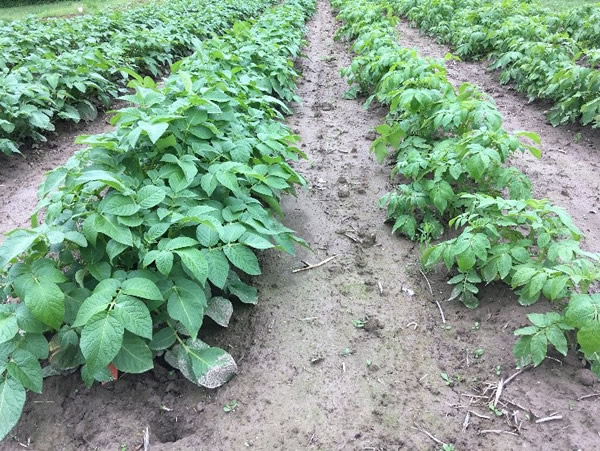
Current growth on potatoes (above); left row, Kennebec and right, Yukon Gold. Cereal rye in full anthesis (flowering)(right). Photos: N. Johanning.
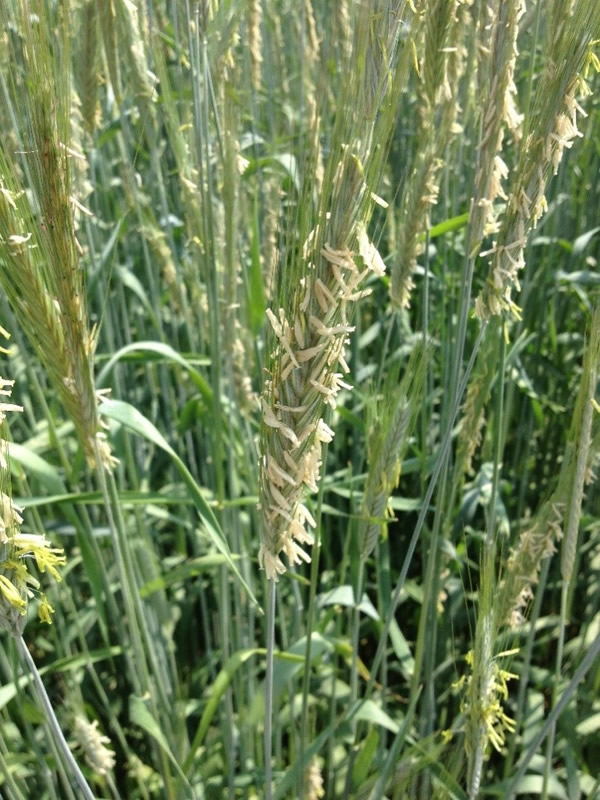
I have about 3000 tomato and pepper transplants that are anxiously waiting to be set out in research trials looking at different tillage, cover crops, and production practices. The no-till plots could probably get snuck in with a few dry days but where tillage and/or plastic needs to be laid, its going to take more time. The cereal rye is now in full flower (anthesis). This time or shortly after is the ideal time to use a roller crimper for termination. If you try to crimp before anthesis, the plant will tend to want to send up new shoots, where after that point the plant is focused on seed production and no longer tends to regrow.
Apples are about ½ to ¾” in diameter and so far, looking good. Strawberries are in full harvest. The crop looks good and although the rain and clouds aren’t ideal the mild temperatures are allowing for a fairly long harvest window. Plasticulture production has been harvesting for more than 3 weeks now with still many green berries to ripen. Blueberries and cherries are really starting to gain size and have a good fruit load. Grapes have flower buds but are not in bloom yet. I would have had apricots at least on my ‘Wilson Delicious’, however, the deer have already cleaned them off along with some apples, however the apple trees are much taller thankfully. This past winter we lost our Lab/Great Pyrenees mix to cancer, who was a very good protector from wildlife. I especially appreciated her “Pyrenees protectiveness” even over some other breeds we had in the past. This is probably the first time in many years (possibly over 100) that there has not been a dog on the farm. I am realizing just how much she did based on all of the injury I am seeing. Never underestimate the value of a good larger breed “farm dog” as a tool in wildlife prevention. Hopefully we will find a new pup soon!
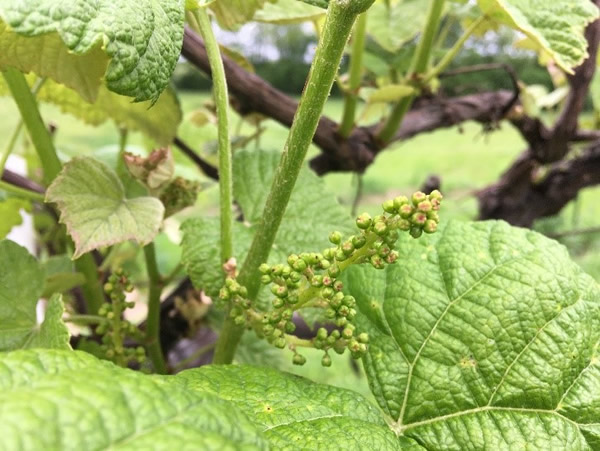
Current growth on potatoes (above); left row, Kennebec and right, Yukon Gold. Cereal rye in full anthesis (flowering)(right). Photos: N. Johanning.
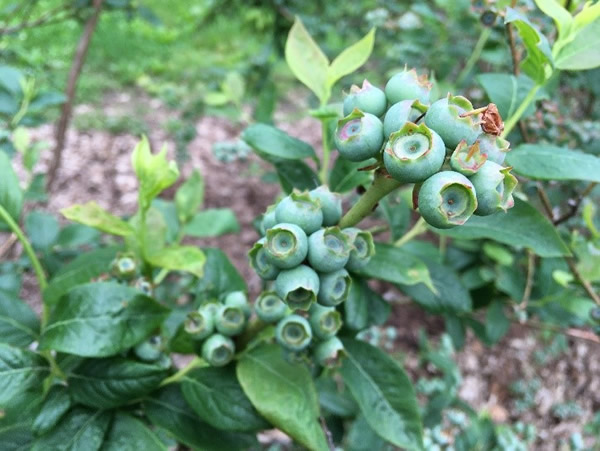
Current growth on table grapes, ‘Mars’ (left) and blueberries, ‘Duke’ (right). Photos: N. Johanning
Nathan Johanning (618-939-3434; njohann@illinois.edu)
From southern Illinois (Murphysboro)… We have been busy at the Jackson County office this month. To date the asparagus patch has been harvested 18 times and 25 pounds of asparagus has been donated to the Murphysboro food pantry. The trial will be harvested until the end of May.
Outside on the plastic rows we have a 10 variety heirloom tomato showcase that was planted April 22, these were covered with a row cover one time when night temperatures dropped to almost freezing. This Tuesday, May 19, we transplanted almost 200 ‘Red Deuce’ tomato plants for a fertigation trial that will be focusing on potassium rates. Due to the weather conditions being less than ideal, the transplants got a little taller than we would like to see before we could plant them. It is important to remember to plant these “leggy” plants a little deeper in the soil to offer more support to the plant.
The high tunnel has been planted with various cut flowers including, zinnias, carnations, stock, and snapdragons. A sample of peppers were also planted in the tunnel on the May 14. These include ‘Sweetie Blend’ snacking peppers, jalapeno, and banana peppers. The heirloom tomatoes from the showcase are also represented in the high tunnel.
Thanks to Bronwyn Aly and Julie Zakes at Dixon Springs Ag Center for starting my tomato and pepper plants.
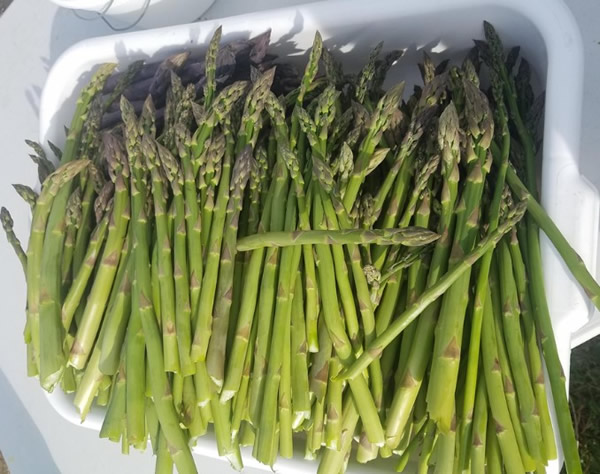
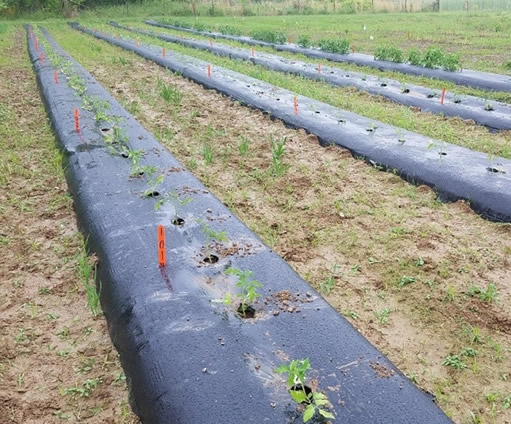
L to R: Asparagus harvest continues; ‘Red Deuce’ tomato planted in replicated potassium fertility trial and heirloom tomato showcase also planted. Photos by K. Bell.
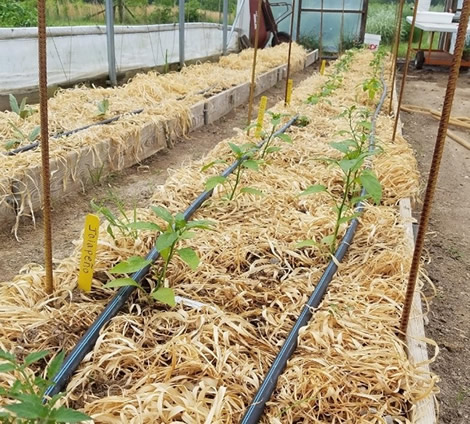
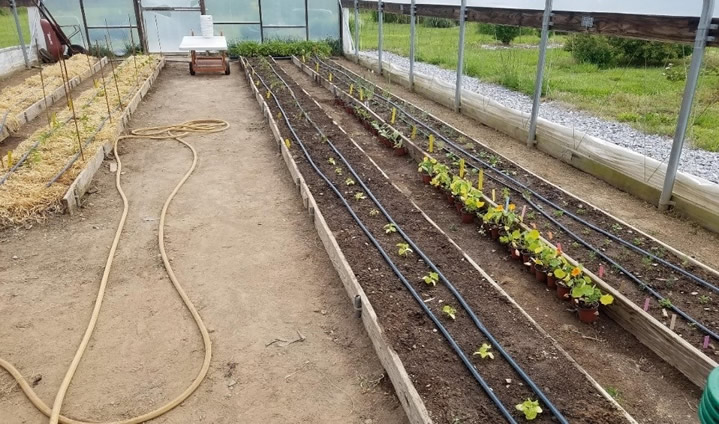
L to R: Peppers planted into oat cover crop residue in high tunnel; various cut flowers planted in high tunnel. All of these plantings are located at the Jackson County Extension Office. Photos by K. Bell.
Katie Bell (618-687-1727; klbell@illinois.edu)
From Dixon Springs Ag Center…Since the last newsletter, it seems like we have had overall cooler, cloudy conditions, with a couple of nights at or near freezing. We do see a day or two of sunshine between rain showers/clouds, but at DSAC, we haven’t really experienced daytime temperatures above 80-85 degrees in the past month (maybe one or two days). Now, within the high tunnels, temperature is a different story, as it should be as their whole purpose is to extend the growing season.
Within the hydroponic tunnel, we have strawberries, tomatoes, peppers, cucumbers, lettuce, and herbs growing in different systems. The ‘Monterey’ strawberries are growing well in the vertical stacks and we have started collecting yield data, generally picking two times per week. Tomatoes and peppers are continuing to grow, with most tomatoes starting to put size on the first green fruit. These plants are being trained and clipped up the single trellis string and suckers continue to be removed during the training process. Cucumbers are setting lots of flowers and fruit is sizing quickly (I ate the first cucumber of the season last night for supper) and we expect first harvest to be this coming Friday, May 22nd. We have added two additional fertilizer injectors and reconfigured the main irrigation lines and solenoid wiring in order to deliver a higher rate of nutrients to the tomato and pepper rows. In the past, we have run all of the crops fertility based on the typical EC (electric conductivity) range for cucumber production, but this new configuration will allow us to run a higher EC (more nutrients) to the tomatoes and peppers.
L to R: ‘Monterey’ strawberries growing in vertical stacks, with 20 plants per stack, with three different substrate blends; cucumber plants setting lots of flowers and fruits sizing quickly; cucumbers trellised with clippers to a single string system. Photos by B. Aly.
L to R: Indeterminate tomatoes sizing first green fruit and trellised to a single string system; NFT lettuce table back in production with lettuce, pak choi, and spinach currently. Photos by B. Aly.
The only plots remaining to be harvested from the winter vegetable high tunnel project are the February seeded carrots. The January seeded carrots were harvested last week. After the February carrots are harvested, the beds in this high tunnel will be prepped and readied for planting plots for year 2 of the winter vegetable high tunnel project.
The biggest challenge we have faced in the past month has been with the determinate tomato variety trial. The replicated plots within the project take up four in-ground raised beds within the tunnel. One bed has some type of issue that is not allowing the transplants to grow at all. In examining the plants, the roots have not grown at all from the time they were planted. This bed was in cucumber production last season. All beds within this tunnel were steamed prior to planting. Another issue with this trial was the discovery of a disease called Tomato Pith Necrosis. I have attached a whole article on this disease in the Fruit and Vegetable Production section of this issue. We have never had this disease in the past, but the cool, cloudy humid weather and excessive nitrogen seem to be the trigger for this problem this season. The peppers had somewhat stalled with the cool, cloudy weather, but they have finally started to grow, setting flowers and darkening up in color.
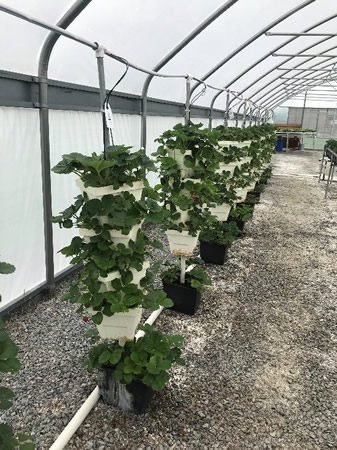
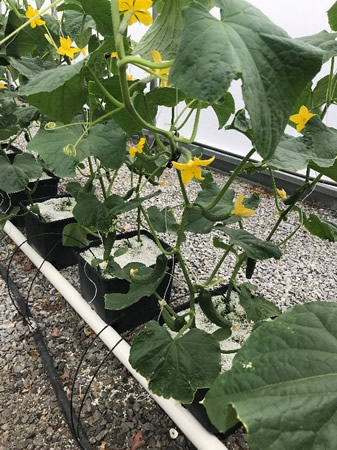
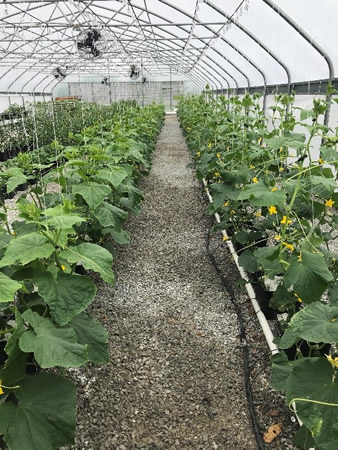
L to R: ‘Monterey’ strawberries growing in vertical stacks, with 20 plants per stack, with three different substrate blends; cucumber plants setting lots of flowers and fruits sizing quickly; cucumbers trellised with clippers to a single string system. Photos by B. Aly.
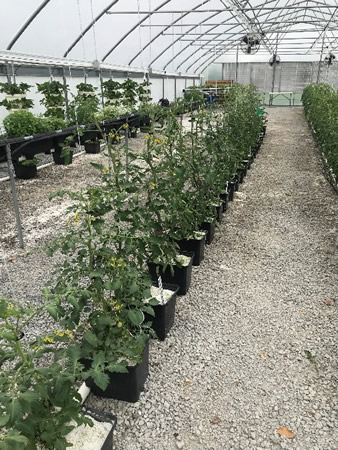
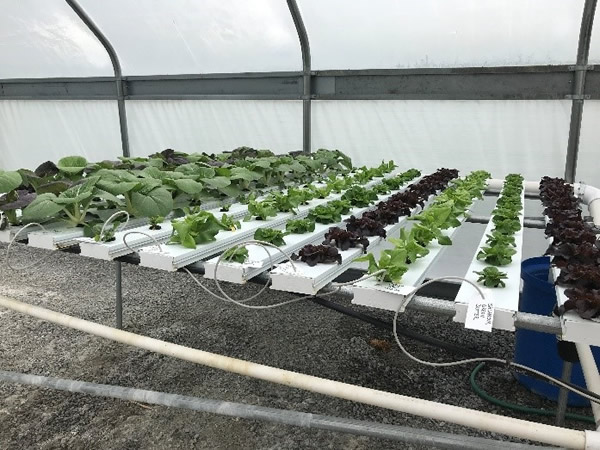
L to R: Indeterminate tomatoes sizing first green fruit and trellised to a single string system; NFT lettuce table back in production with lettuce, pak choi, and spinach currently. Photos by B. Aly.
The only plots remaining to be harvested from the winter vegetable high tunnel project are the February seeded carrots. The January seeded carrots were harvested last week. After the February carrots are harvested, the beds in this high tunnel will be prepped and readied for planting plots for year 2 of the winter vegetable high tunnel project.
The biggest challenge we have faced in the past month has been with the determinate tomato variety trial. The replicated plots within the project take up four in-ground raised beds within the tunnel. One bed has some type of issue that is not allowing the transplants to grow at all. In examining the plants, the roots have not grown at all from the time they were planted. This bed was in cucumber production last season. All beds within this tunnel were steamed prior to planting. Another issue with this trial was the discovery of a disease called Tomato Pith Necrosis. I have attached a whole article on this disease in the Fruit and Vegetable Production section of this issue. We have never had this disease in the past, but the cool, cloudy humid weather and excessive nitrogen seem to be the trigger for this problem this season. The peppers had somewhat stalled with the cool, cloudy weather, but they have finally started to grow, setting flowers and darkening up in color.
For those who may be interested in seeing a weekly video with updates and the progression on projects being conducted in the high tunnels at DSAC, visit our Illinois LocalFoods YouTube channel and check out the Local Food Happenings at DSAC There are now eight videos posted on the site, starting with April 3rd and going through May 15th. The plan is to record a new video each Friday and post to the site, which sometimes may not be until Saturday. If you have questions on something you see, please feel free to send me an email or pop the question into the comments under the video.
Bronwyn Aly (618-382-2662; baly@illinois.edu)
Fruit & Vegetable Production & Pest Management
Cleaning, Sanitization, and Disinfection on the Produce Farm: What’s the Difference and Why Does It Matter?
There has never been a more important time than now to review food contact surface and high touch surface cleaning, sanitization, and disinfection procedures. Food safety systems on produce farms should always be given the attention to detail we apply to our other farm systems. New federal food safety guidelines from the FDA and the emerging SARS-Cov-2 virus (cause of COVID-19) give farmers new pause to consider how robustly they have built out their food safety practices.
In the course of taking produce safety training, the often-repeated mantra of “you cannot clean a dirty surface” is drilled into farmers minds. The idea is simple, before a sanitizer is effective on a surface, it must be cleared of dirt and organic debris that renders sanitizer less effective. Cleaning and sanitizing is really a four-step process that involves removing obvious debris, cleaning with a detergent, rinsing, and ending in a sanitizer application to a surface and allowed to air dry. This procedure for food contact surfaces should be repeated as a part of your normal operation.
The terms cleaning and sanitizing are now well understood by produce farmers. However, an often overlooked aspect of maintaining food safe environments needs new attention in the age of SARS-CoV-2. This is the concept of disinfection. The difference between sanitization and disinfection is primarily in the concentration of the anti-microbial applied and when the event takes place. Look at these definitions and a table comparing three common anti-microbial products:
“Cleaning removes germs, dirt, and impurities from surfaces and objects…using soap (or detergent) and water to physically remove [them].”
“Sanitizing lowers the number of germs on surfaces or objects to a safe level, as judged by public health standards or requirements.”
“Disinfecting kills germs on surfaces or objects. Disinfecting works by using chemicals to kill germs on surfaces or objects. This process does not necessarily clean dirty surfaces or remove germs, but by killing germs on a surface after cleaning, it can further lower the risk of spreading infection.”
General comparison of three common anti-microbial products2
Product |
Active Ingredients |
Labeled Concentration for Wash Water Treatment |
Labeled Concentration for Sanitizing Hard Surfaces |
Labeled Concentration for Disinfecting Hard Surfaces |
Tsunami 100** |
15.2% Peroxyacetic Acid (PAA) and 11.2% Hydrogen Peroxide |
30-80 ppm PAA |
150-270 ppm PAA 1.0-1.8 fl oz of product per 8 gallons of water. 1 min contact time. Air Dry |
Not Labeled! |
Sanidate 5.0** |
5.3% Peroxyacetic Acid (PAA) and 23% Hydrogen Peroxide |
27-96 ppm PAA |
147-500 ppm PAA 1.6-5.4 fl oz of product per 5 gallons of water. 1 min contact time. Drain? |
230-1000 ppm PAA |
Ultra Clorox Brand Regular Bleach*** |
6% sodium hypochlorite |
25 ppm free chlorine |
200 ppm free chlorine |
2700 ppm free chlorine |
*Always consult product labels for EPA registration confirmation and proper labeled usage for a given situation. Based on review of EPA labels for educational reference. Always confirm your label and wear proper personal protective equipment. Confirm products with organic certifier.
**Product NOT listed on EPA List N
***Product listed on EPA List N
The decision to sanitize or disinfect should be based on the probability of the presence of a known hazard. For instance, during normal washing and packing of produce where typical levels of outside food borne pathogens are possibly present, then routine cleaning and sanitizing guidelines in your produce safety plan should be followed. However, if you have a known or highly probable hazard present (e.g. visible feces on produce, blood, or an employee is found to be or is suspected of being ill with a communicable disease) then cleaning and disinfecting is appropriate. The cleaning and disinfecting step would typically be used on specific surfaces with visible contamination. However, considering SARS-CoV-2’s uncertainty when it comes to surface survival and its inability to be seen, growers may want to consider cleaning and disinfecting certain “high contact surfaces” in and around the farm. These surfaces may vary from farm to farm, but could include things like frequently used door handles, equipment, bins, point of sale equipment, chairs, tables, and other heavily touched surfaces.
It is important to note in the above table that the concentration of the active ingredient will vary significantly depending on the labeled use. Currently, there are no labeled sanitizers or anti-microbial products labeled for SARS-CoV-2. Some products may be labeled for other coronavirus or similar hard to kill viruses. The EPA is currently providing “List N”, which highlights disinfectants that are currently approved for use against SARS-CoV-2. Here you can cross reference your current products with List N. Only products on List N can legally be used against SARS-CoV-2. Even if a product on List N has a similar formulation to your product it cannot be used unless it is on the list. Be sure to follow the labeled instructions carefully as they pertain to the indicated virus on List N.
One other thing to note about the disinfection procedures. The high concentrations of a sanitizer product used for disinfecting are not meant to remain in contact with food contact surfaces. After cleaning the surface, apply the disinfectant. Follow labeled instructions on the amount of time the wet solution should remain on the object. After the indicated contact time, it is recommended that the food contact surface be rinsed with water, then re-applied with a normal sanitizer rate solution and allowed to air dry This seems counter-intuitive after you have disinfected a surface, but it is a current best practice recommended by sanitizer product manufacturers.
There is still much to learn about the new public health situation we find ourselves in. Building on the existing food safety procedure you may already have in place will help maintain a safe work environment and provide quality produce to your customers. Here are some other useful links for more information, some of which guided this article:
Helpful Links
Cornell FAQ for the Food Industry
Sanitizers and Disinfectants: The Chemicals of Prevention
References
U.S. Centers for Disease Control and Prevention. 2020. How to Clean and Disinfect Schools to Help Slow the Spread of Flu. https://www.cdc.gov/flu/school/cleaning.htm
2 Callahan, Chris. “A Guide to Cleaning, Sanitizing, and Disinfecting for Produce Farms”. UVM Extension Ag Engineering. 3/30/2020. https://blog.uvm.edu/cwcallah/2020/03/30/clean-sanitize-disinfect/
Zack Grant (708-679-6889; zgrant2@illinois.edu) with review and input from Laurie George (618-548-1446; ljgeorge@illinois.edu)
Modified Growing Degree Days for Insect Development (Base 50⁰ F, January 1 – May19)
Station Location |
Actual Total |
Historical Average |
One- Week Projection |
Two-Week Projection |
Freeport |
209 |
330 |
283 |
367 |
St. Charles |
234 |
319 |
303 |
380 |
DeKalb |
220 |
366 |
300 |
390 |
Stelle |
270 |
420 |
355 |
450 |
Peoria |
329 |
460 |
414 |
508 |
Monmouth |
320 |
423 |
404 |
497 |
Champaign |
354 |
466 |
445 |
546 |
Springfield |
389 |
524 |
490 |
600 |
Perry |
402 |
507 |
492 |
591 |
Brownstown |
440 |
594 |
546 |
661 |
Olney |
475 |
576 |
578 |
692 |
Belleville |
565 |
633 |
674 |
793 |
Rend Lake |
547 |
686 |
663 |
789 |
Carbondale |
618 |
656 |
727 |
848 |
Dixon Springs |
608 |
719 |
722 |
846 |
Insect development is temperature dependent. We can use degree days to help predict insect emergence and activity. Degree day accumulations calculated using the Pest Degree-Day Calculator
Kelly Estes, State Survey Coordinator, Illinois Cooperative Agricultural Pest Survey (217-333-1005; kcook8@illinois.edu)
Specialty Crops Soil Health Podcast
No-Till Pumpkins is the first specialty crops topic in the HAT-Soil Health Podcast from Conservation Cropping Systems Initiative (CCSI) in partnership with Purdue University and Hoosier Ag Today (HAT). In this episode, Amanda and Jacob Baird, beginning pumpkin farmers in Tipton County, join University of Illinois Extension Educator Nathan Johanning and no-till pumpkin farmer Rod Johnson of Hobart, Indiana to learn the tips and tricks of successful u-pick no-till pumpkins - from cover crops to dealing with rodents.
Find the podcast at https://www.ccsin.org/podcast or https://www.hoosieragtoday.com/category/hat-soil-health-podcast/, or subscribe to it on Stitcher, Spotify, iTunes, or Google Play.
Future monthly episodes on specialty crops will cover protecting pollinators and beneficials in cucurbits, managing cover crops on diverse vegetable farms, and other practices to improve soil health on fruit and vegetable farms. Listen in and learn from farmers, educators, and researchers.
Nathan Johanning (618-939-3434; njohann@illinois.edu)
Overview of Tomato Pith Necrosis
With the discovery of Tomato Pith Necrosis on several of the determinate tomato plants in the in-ground beds in the high tunnel at DSAC, I decided to write a summary of information I found regarding this disease. I first noticed symptoms on three or four plants on May 8th, which was 5 weeks after the tomatoes had been transplanted into the tunnel, and as of May 19th, I have removed 12 plants out of the 156 plants in this planting (roughly 8% plants).
Tomato Pith Necrosis is caused by the bacterium Pseudomonas corrugata, and other soil-borne species of Pseudomonas, and although it is considered a weak pathogen, P. corrugata has the ability to attack plants growing too hard. This disease is typically seen on early planted tomatoes that experience cool night temperatures, high humidity, and vigorous growth due to excessive levels of nitrogen. In my opinion, all three of these factors have occurred in the planting at DSAC. Our weather pattern for the past month or so has been very conducive to cool temperatures and high humidity. The excessive nitrogen, which causes plants to grow hard and fast, is human error, as I decided to put on a pre-plant application of 12-12-12. I felt like we were always playing catch-up with fertilizer on tomatoes and thought some pre-plant would help give us a good starting point.
Symptoms of this disease can include: a) dark brown to blackish lesions on the stems and leaf petioles; b) adventitious roots growing inside the stem; c) shrunken, collapsed, hollow or degraded stems; d) the pith in the center of the stem will be discolored (easily seen if cut longitudinally); e) chlorosis and wilting of the top part of the plant. While most of the literature suggested that symptoms are not typically seen until the first fruit clusters are at the mature green stage, symptoms in our planting began when the first fruit clusters were still ping pong ball in size.
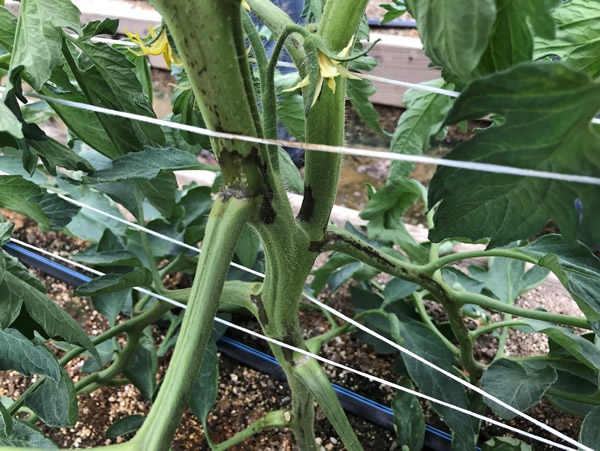
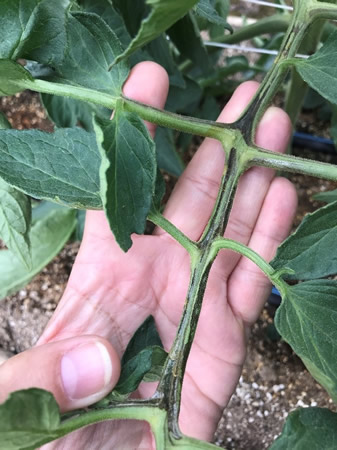
Left and right photos show dark lesions on the stems and petioles of the tomato plant in planting at DSAC.
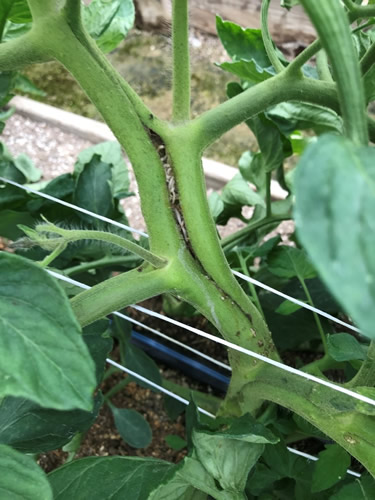
b) Adventitious roots growing from stem.
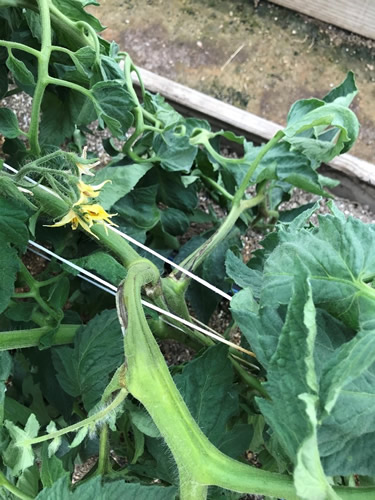
c) Stem shrunken, collapsing and degraded.
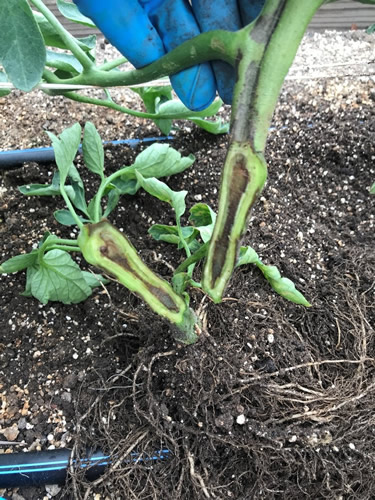
d) Discoloration of pith in center of stem.
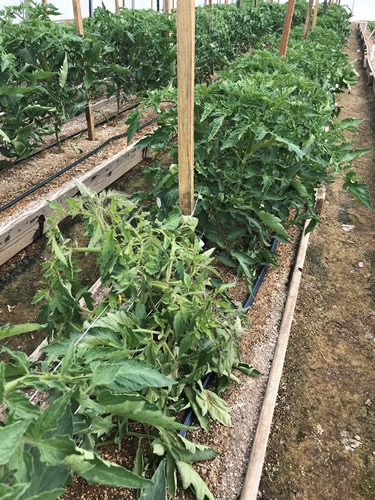
e) Top part of plant is wilting.
All photos by B. Aly.
Recommendations to prevent Tomato Pith Necrosis include:- Soil test prior to planting and make fertilizer applications based on test results. Avoid excessive pre-plant nitrogen fertilization especially in early-planted, high tunnel tomatoes. Take away the need for guessing or estimating on fertility and utilize the tool that is already in place to help growers.
- Improve ventilation in high tunnels or greenhouse to help lower humidity levels. This can include HAF fans, opening end walls and venting side curtains for longer periods, and tying and suckering in a timely manner to allow more airflow through the plants.
- Practice good sanitation when removing crop at the end of season and especially if removing infected plants during the season. As this disease could overwinter on crop residue or debris (much like many diseases of tomatoes), make sure it is removed from the planting field or incorporated completely to speed up decomposition. Crop rotation is always a good practice. Sanitize stakes, pruning tools, or any surface that remaining plants may come in contact with or that may be reused the following season. I removed the complete plant, including the roots, placed all of the plant material (even the tiniest pieces of leaf on the soil around where the plant had been) in a trash bag and carried out of the tunnel, and used a bleach solution to wipe down the tomato twine that had been in contact with the plant.
As there are no effective treatments for this disease, prevention to minimize occurrence is the best management practice. Literature does mention that plants may recover if there is an improvement in environmental conditions, allowing for sunny, warmer weather. I believe we have a pretty severe incidence of infection in our planting as the 12 plants that were removed would not have recovered. Based on yield data from the previous two years of production and using a price estimate of $2.00 per pound on tomatoes, I would estimate that the potential in lost revenue of these initial plants has a value of $500-$600.
Please use the information in this article as a cautionary tale… it is much easier to add additional fertilizer throughout the season than to apply to much fertilizer in the beginning of the season, you can’t remove the excess. Soil test and follow the recommendations!
One very important reminder to growers regarding disease diagnosis on any specialty crops, make sure you get an accurate diagnosis before you start a treatment program. The University of Illinois Plant Clinic provides this service and they are currently open and able to receive samples (see article in News and Announcements).
Informational links on Tomato Pith Necrosis
https://ag.umass.edu/vegetable/fact-sheets/tomato-pith-necrosis
https://vegcropshotline.org/article/pith-necrosis-of-tomato/
https://extension.umn.edu/diseases/pith-necrosis-tomato
http://blogs.cornell.edu/livegpath/gallery/tomato/pith-necrosis-on-tomatoes/
Bronwyn Aly (618-382-2662; baly@illinois.edu)
Less Seriously
https://messages.365greetings.com/quotes/funny-quotes-life.html
- Life is short. Smile while you still have teeth.
- Life was much easier when apple and blackberry were just fruits.
- At the end of the day life should ask us, Are you sure you want to save the changes?
- Common sense is like deodorant. The people who need it most never use it.
- One day I’m gonna make the onions cry.
- I hate it when people are at your house and ask “Do you have a bathroom? No we pee in the yard.
- Sunglasses: allowing you to stare at people without getting caught. It’s like facebook in real life.
- Be decisive. Right or wrong, make a decision. The road of life is paved with flat squirrels that couldn’t make a decision.
- That awkward moment when you’re wearing Nike’s and you can’t do it.
- Hope for the best, Expect the worst. Life is a play, we’re unrehearsed. – Mel Brooks
University of Illinois Extension Specialists in Fruit and Vegetable Production & Pest Management
Extension Educators – Local Food Systems and Small Farms |
||
Bronwyn Aly, Gallatin, Hamilton, Hardin, Pope, Saline, and White counties |
618-382-2662 |
|
Katie Bell, Franklin, Jackson, Perry, Randolph, & Williamson counties |
618-687-1727 |
|
Sarah Farley, Lake & McHenry counties |
847-223-8627 |
|
Nick Frillman, Woodford, Livingston, & McLean counties |
309-663-8306 |
|
Laurie George, Bond, Clinton, Jefferson, Marion, & Washington counties |
618-548-1446 |
|
Zachary Grant, Cook County | 708-679-6889 | |
Doug Gucker, DeWitt, Macon, and Piatt counties |
217-877-6042 |
|
Erin Harper, Champaign, Ford, Iroquois, and Vermillion counties |
217-333-7672 |
|
Grace Margherio, Jackie Joyner-Kersee Center, St. Clair County |
217-244-3547 |
|
Grant McCarty, Jo Daviess, Stephenson, and Winnebago counties |
815-235-4125 |
|
Katie Parker, Adams, Brown, Hancock, Pike and Schuyler counties |
217-223-8380 |
|
Kathryn Pereira, Cook County |
773-233-2900 |
|
James Theuri, Grundy, Kankakee, and Will counties |
815-933-8337 |
|
Extension Educators – Horticulture |
||
Chris Enroth, Henderson, Knox, McDonough, and Warren counties |
309-837-3939 |
|
Richard Hentschel, DuPage, Kane, and Kendall counties |
630-584-6166 |
|
Andrew Holsinger, Christian, Jersey, Macoupin, & Montgomery counties |
217-532-3941 |
|
Extension Educators - Commercial Agriculture |
||
Elizabeth Wahle, Fruit & Vegetable Production |
618-344-4230 |
|
Nathan Johanning, Madison, Monroe & St. Clair counties |
618-939-3434 |
|
Campus-based Extension Specialists |
||
Kacie Athey, Entomology |
217-244-9916 |
|
Mohammad Babadoost, Plant Pathology |
217-333-1523 |
|